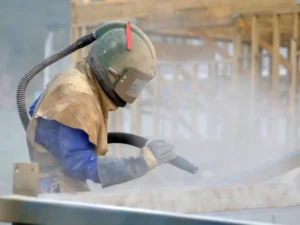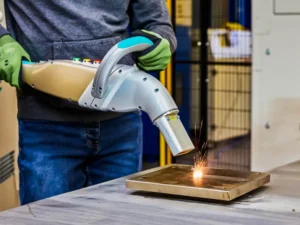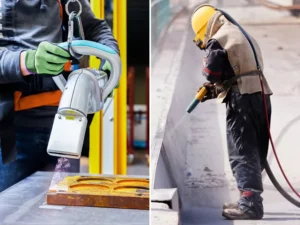Introduction:
Pristine surfaces get covered with dust, grime, and other impurities as time passes. Several cleaning technologies came into existence to fight this battle. Among these techniques are two popular methods used in the industry. They are Sandblasting and Laser Cleaning.
As a traditional method, sandblasting has a long and storied cleaning history. It is a forceful approach that uses abrasive materials like sand to strip away dirt at high speeds. Alternatively, laser cleaning is a more peaceful process. It is a new tech that uses laser beams to remove contaminants with precision from our surfaces.
Both methods have advantages and disadvantages that make them suitable for different applications. Laser cleaning VS sandblasting, what is the difference? This article will compare them. We will explore their mode of operation, pros and cons, and various applications. But before that, here is a brief overview of each technique.
What is Sandblasting?

Also known as abrasive blasting, the sandblasting process is forceful by nature. It operates by using rough materials to hit surfaces at high speed. The impact of the medium (usually sand) removes impurities and cleans the surface. Alternative abrasives used in surface treatment are steel grits, walnut shells, and glass beads. However, in sandblasting machines, sand is the main cleaning medium.
The applications of sandblasting vary across industries. For example, automotive industries use this method to clean cars and their components. In construction, sandblasting machines help prepare surfaces for painting by removing old paint. You will find other uses of Sandblasting in heavy-duty industries that need repair and maintenance of their machines.
What is Laser Cleaning?

Between laser cleaning and sandblasting, the latter classifies as a traditional process. Laser cleaning, on the other hand, is more recent and advanced. It is a trendy, tech-savvy newcomer that uses laser beams to vaporize contaminants. These laser beams provide a gentle process that protects the surface material from damage.
The operating mechanism of laser cleaners is like any other laser device. Laser beams from these machines have high temperatures. They interact with impurities that rapidly absorb the lasers before turning into gases. The result of this is a clean surface. Laser cleaning is precise, effective, green, and non-contact. Moreover, it has a wide range of uses in many industries. These industries include electronics, construction, automotive, medical, and aerospace.
The Unveiling Between Sandblasting VS Laser Cleaning
As industrial cleaning processes, laser cleaning and sandblasting are well-known. They are efficient and quick to produce results. However, they each have individual properties that set them apart.
1. Sandblasting VS Laser Cleaning: Effect on the Surface
By now, you know that laser cleaning uses powerful laser beams to turn impurities into gas. Vaporizing contaminants use less energy than the amount that will damage the surface. We call the energy expended here the ‘ablation threshold.’ When you cross this threshold, the risk of damaging the surface increases.
This unique trait is one of the reasons why laser cleaning is a perfect choice for your needs. Laser cleaners provide complete control over the intensity of your lasers. This amount of mastery is non-existent among other methods. As a result, while cleaning with lasers, the surface material retains zero risk of damage.
In comparison, sandblasting uses sand, a rough material, as its cleaning tool. Because of this, it tends to leave more impact on the surface than laser cleaning machines. Sandblasting could cause dents, scratches, and breaks on the substrate. These make it unsuitable for materials that require a delicate touch, like artifacts.
2. Laser Cleaning VS Sandblasting: Environmental Effects
Since laser cleaners vaporize contaminants, there is little dust and zero waste production. So, it contributes to ensuring a greener future free from pollution and health issues.
In contrast, sandblasting produces a lot of dust particles during use. These particles reduce the surrounding air quality and cause respiratory issues among workers. Therefore, it is crucial to dispose of the waste from sandblasting properly.
3. Sandblasting VS Laser Cleaning: Efficiency and Cost
When considering cost, laser cleaning machines cost more than sandblasters. A laser cleaner is an expensive device that costs anything from $11,000. This steep initial cost makes these machines inaccessible to many small businesses. The price goes even higher for larger laser machines with more complex mechanisms.
However, although laser cleaners are expensive, their efficiency is not doubted. They provide users with quick and accurate results. In addition, these devices have low maintenance costs because they only consume electricity.
In contrast, cost-wise, sandblasting is more affordable. Moreover, it is easy to operate and needs only a few pieces of equipment. The main requirements are the blasting pot, sand mixture, nozzle, and compressor.
When we describe the process as traditional, we mean it literally. The process was first invented in 1870 and still exists even now. This means that sandblasting has faced countless stages of improvement since its creation. The result of this consistent growth is an effective cleaning process.
4. Laser Cleaning VS Sandblasting: Safety
When it comes to protection, laser cleaning is much safer than sandblasting. Its non-contact nature gives handlers an obvious advantage.
The risk of injury is reduced since there is no direct contact between the workers and the surfaces. The machine also has extra safety features, such as sensors and shields, which allow the operator to enjoy a risk-free working session.
In comparison, sandblasting is a forceful process that uses abrasive materials. Therefore, workers who fail to use the appropriate safety gear may incur serious injuries.
Laser Cleaning VS Sandblasting- Which is the Better Option?

We have come a long way in comparing these two cleaning methods. After exploring their pros and cons, you may choose which technique suits you best.
Take your project into account when deciding. Pick laser cleaning if you need a method that reduces waste and protects your material. And if your project involves cleaning a large area or has a limited budget, choose sandblasting.
If you’re finding it challenging to select from either method, do go through the comparison again. Our detailed guide is sure to help you find what you require. You can also contact our experts for advice should you face a problem.
